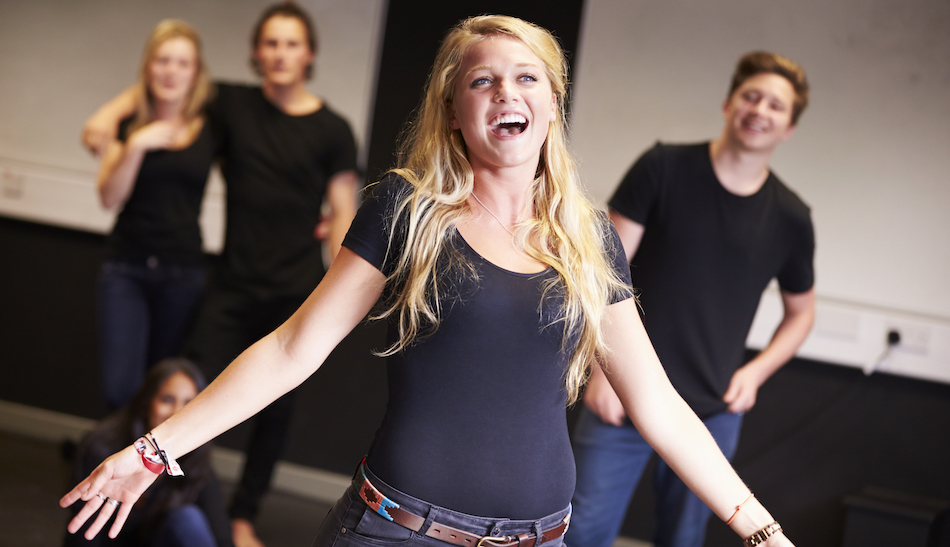
Improvising a solo is pretty daunting, but when you pull it off, it leaves both you and the audience a bit in awe that you managed to pull together a complete song by yourself..and one that actually sounds like a real song. Musical improv solos are tough because you are more or less on your own (save for your accompanist), but wow, they are satisfying to perform. So, here are some tips for nailing a solo in a musical improv show.
Musical improv solos express and clarify a character’s wish or desire, which helps direct the improvised musical’s plot. Improv solos are typically sung by the protagonist or antagonist, express an “I want” statement, and can take several forms, such as a verse-chorus or a tagline structure.
But how exactly do you improvise a solo? Saying it’s about a character’s want is easy, but actually making up a song by yourself is something else. Below, I discuss who should sing a solo in the contest of an improvised musical, what solos are about, tips for musical improv solos, as well as some common solo song structures.
The Purpose of Musical Improv Solos: Establishing a Want
So, you’re putting on an improvised musical. Whether it’s 20 minutes or an hour long, you’re probably going to have at least one solo. Think of any real-life musical: you’ll be hard-pressed to find one without a solo (or several).
And if you look closely at what these solos are about and who sings them, you’ll discover that solos are about a main character’s want or desire, a desire so strong that they sing a whole song about it.
Who Sings a Solo?
In an improvised musical, the protagonist almost always sings a solo.
If you have time for more than one solo, the antagonist (if you have one) might also sing a solo. But, the bottom line is that whoever sings a solo must have a very strong want. And this typically means it’s a major character whose want drives the plot of the musical.
Solos are important in an improvised musical because they express the main character’s want, and their want is what the whole story revolves around. In a “real” musical, you’d likely have several characters’ wants driving the story, but in an improvised musical, it can be helpful to just focus on one want and then see where your improvisation takes you naturally.
A Solo Is about an “I Want” Statement
Solos express an “I want” statement. They tell us what our protagonist desires, their overarching goal – a desire strong enough to sing a song about it.
Solos are vital because they help you, as improvisers, determine very quickly what your improvised musical is about.
It can be daunting to try to create a cohesive storyline in 30 minutes, complete with song and (attempts at) dance. But there’s a shortcut: Your musical is about what your protagonist wants, and your musical ends with your protagonist either getting what they want or failing to get what they want. (Or, failing to get what they want but realizing it wasn’t really what they wanted at all.)
Here are some solo examples from real-life musicals:
- “Maria” from West Side Story. Sung by Tony. Character’s want: Get together with Maria. This is the want the whole musical hinges on: the love between Tony and Maria.
- “Part of Your World” from The Little Mermaid. Sung by Ariel. Character’s want: Join the human world above. The song is explicitly about this want, which drives the whole musical.
- “Home” from Beauty in the Beast. Sung by Belle. Character’s want: To return home to her father, who she’s been separated from. This isn’t the sole driving want of the musical, but it is a big one. Belle has more than one solos, each about a different want.
- “Waving Through a Window” from Dear Evan Hansen. Sung by Evan Hansen. Character’s want: To stop always being “on the outside looking in.” This is a big factor driving the events of the musical.
- “On My Own” from Les Miserables. Sung by Eponine. Character’s want: To be loved by Marius and no longer be on her own. This musical has so many “main” characters, but Eponine’s character arc is driven by this want.
This list could go on. The point is, an improvised solo is a great way to clearly establish what your main character wants so that your whole team is on the same page.
TAKEAWAY: If you’re singing an improv solo, focus on a major thing your character wants. This will not only help give form to your musical, but it will focus your song on one powerful (and emotional) topic.
Musical Improv Solo Tips
So, you know who should (typically) sing a solo and that it should revolve around a want. Now what? Here are some tips I’ve picked up from musical improvisers with a lot more telent than me:
- Start with a clear character: It can feel daunting to being an improv solo. Singing as your character (which you’ll have already developed somewhat at this point in the musical) will help keep you focused. How would your character react? What would their body language be?
- Focus on your want: The chorus (or tagline) of your song will often be a clear articulation of your want. Since the chorus/tagline will set the theme of your song, this will help make sure all your verses related back to this major theme.
- Dig into your emotions: Your character feels strongly enough about this want that they are singing a full-blown solo. How would they feel right now? Songs in musicals often draw on big emotions.
- Rhymes draw attention: This can be good or bad. If you can improvise a rhyme scheme, by all means, do it! But don’t feel pressure to rhyme if you’ll need to make up lines that don’t quite fit into your song. Rhymes stand out in people’s minds, so if you throw in a rhyme that doesn’t quite fit, the audience is more likely to notice this random inclusion.
- End with a big finish: Make it super clear when you think your song is ending. This will help cue your accompanist and will end your song on a strong, confident note. Musical improviser Michael Pollock advises using the choo-choo train theory of song endings: “In order to bring a song comfortably and satisfyingly to a close, we need to do it gradually,” like a train slowly slowing down.
- Practice, practice, practice: Practice singing along to prerecorded tracks in the car, while you’re washing dishes, anytime.
Musical Improv Solo Song Structure
Because you’re singing alone, it’s much easier to deviate from a “traditional” song structure in an improvised solo than in a duet or a group number. This gives you a lot more freedom, but can also lead to a confusing song structure for the audience. Picking a general structure for your song will help your accompanist to follow you and your audience to feel that your song is “real.”
Given this, you can, of course, deviate from the below three structures with a lot more freedom than in group songs. 🙂
Verse-Chorus
We’re likely all very familiar with the verse-chorus song structure, in which one sings a series of verses (with similar length and structure) with a repeating chorus in between verses. This structure works well for solos as well as musical improv duets and group numbers.
For example: Verse 1, Chorus, Verse 2, Chorus, Verse 3, Chorus
Note: You can sing your chorus after each verse, or after every 2 verses, etc. Since you’re singing alone, do what feels best for the song. Consistency will help make your song feel more real though.
Tagline
Taglines are kind of like short, snappy choruses. In a chorus song, you’d sing a repeating set of lines (often four lines) as the chorus between verses.
In a tagline song, you repeat one reoccurring line (either the first line of each verse or the last line) to tie together the main theme of your song. This tagline is always the first or last line of every verse, except for the bridge, where you can deviate from the tagline.
An easy example is Part of Your World” from The Little Mermaid. This song doesn’t have a traditional chorus, but Ariel repeats “…part of your world” over and over again throughout the song, and this refrain ties the whole song together. That’s the tagline.
Here’s the structure for a first-line tagline song (the tagline could also be the last line of each verse):
V1: Tagline Second Line Third Line Fourth Line V2: Tagline Second Line Third Line Fourth Line Bridge: First Line (no tagline) Second Line Third Line Fourth Line V4: Tagline Second Line Third Line Fourth Line
Tagline songs are great for solos because repeating a chorus over and over can make your song super long.
Choruses are awesome for duets and group numbers because they provide an opportunity for the whole group to sing together in unison (which is very impressive to the audience in an improvised musical). But you don’t need to coordinate with anyone else in a solo, so you can get away with a tagline very easily.
Other Improv Solo Elements
Intro/Vamp
Musical theatre songs often use the intro/vamp section of a song to ramp up to verse 1. You can jump right into the first verse, but you can also play around with the intro section first.
The Bridge
In a solo, the bridge is a great place to express doubt (in yourself, in your want, in the obstacles you face), to show a different emotion, or to become more introspective. The bridge is musically different from the rest of the song, and this gives you a great chance to give your character more depth and/or explore a different angle of your want.
The Ending
As mentioned above, when you’re about to end your song, you want people to know it’s about to end. So, how do you end a song gracefully? Here are three techniques from Michael Pollocks’ amazing book, Musical Improv Comedy: Creating Songs in the Moment:
- Repeat the last 2 lines of your song and hold out the final note
- Sing the last 2 lines 3 times and don’t hold out the last note (ending your song on tempo)
- Hold out the last note of your final line
There’s so much more to say about improvising a solo, but the best way to get better at it is to get out there and do it. A lot. Take some classes, listen to lots of songs and think about their structures, watch musical improv, and practice. It’s still not my forte, to be honest, and until then, you’ll find me belting out songs in the car…and my living room…and the park…and the grocery store… 🙂
